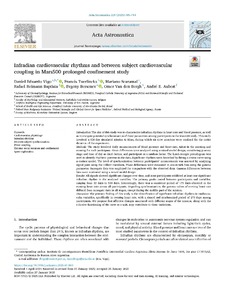Please use this identifier to cite or link to this item:
https://repositorio.uca.edu.ar/handle/123456789/19982| Título: | Infradian cardiovascular rhythms and between subject cardiovascular coupling in Mars500 prolonged confinement study | Autor: | Vigo, Daniel Eduardo Tuerlinckx, Francis Scaramal, Mariano Reimann Baptista, Rafael Bersenev, Evgeny Van den Bergh, Omer Aubert, André E. |
Palabras clave: | RITMO CIRCADIANO; SISTEMA CARDIOVASCULAR; CONFINAMIENTO; ASTRONAUTAS | Fecha de publicación: | 2025 | Editorial: | Elsevier | Resumen: | Introduction: The aim of this study was to characterize infradian rhythms in heart rate and blood pressure, as well as investigate potential synchronization of these parameters among participants in the Mars500 study. This study involved a 520-day simulated mission to Mars, during which six crew members were confined for the entire duration of the experiment. Methods: The study involved daily measurements of blood pressure and heart rate, taken in the morning and evening for each participant. Mean differences were analyzed using a mixed model design, considering journey stage and time of day as fixed factors, and participant as a random factor. The Lomb-Scargle periodogram was used to identify rhythmic patterns in the data. Significant rhythms were described by fitting a cosine curve using a cosinor model. The level of synchronization between participants’ measurements was assessed by analyzing signal pairs using the Hilbert transform. Phase differences were measured in one-month bins using the gamma parameter. Surrogate data was employed for comparison with the observed data. Gamma differences between bins were evaluated using a mixed model design. Results: All signals showed significant changes over time, and most participants exhibited at least one significant infradian rhythm in the analyzed variables. The primary peaks varied between participants and variables, ranging from 22 days to 520 days. Interestingly, there was a consistent period of 173 days observed in the evening heart rate across all participants. Regarding synchronization, the gamma values of evening heart rate differed from surrogate data in all stages, except during the middle part of the mission. Discussion: The primary finding of this study is the identification of significant infradian rhythms in cardiovascular variables, specifically in evening heart rate, with a shared and synchronized period of 173 days among participants. We propose that affective changes associated with different stages of the mission, along with the cohesive functioning of the crew as a unit, may contribute to these variations. | URI: | https://repositorio.uca.edu.ar/handle/123456789/19982 | ISSN: | 1879-2030 0094-5765 |
DOI: | 10.1016/j.actaastro.2025.01.060 | Derechos: | Atribución-NoComercial-CompartirIgual 4.0 Internacional | Fuente: | Acta Astronautica. 2025, 229. |
| Appears in Collections: | Artículos |
Files in This Item:
| File | Description | Size | Format | Existent users please Login |
|---|---|---|---|---|
| infradian-cardiovascular-rhythms.pdf | 6,86 MB | Adobe PDF | Request a copy | |
| infradian-cardiovascular-rhythms.jpg | 438,34 kB | JPEG |  View/Open |
This item is licensed under a Creative Commons License

